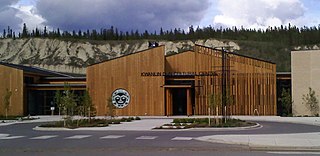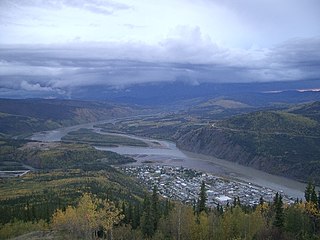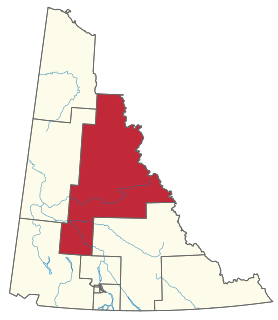Related Research Articles

Yukon is the smallest and westernmost of Canada's three territories. It also is the second-least populated province or territory in Canada, with a population of 40,232 people as of the 2021 Census. Whitehorse, the territorial capital, is the largest settlement in any of the three territories.

The Yukon River is a major watercourse of northwestern North America. From its source in British Columbia, Canada, it flows through Canada's territory of Yukon. The lower half of the river continues westwards through the U.S. state of Alaska. The river is 3,190 kilometres (1,980 mi) long and empties into the Bering Sea at the Yukon–Kuskokwim Delta. The average flow is 6,400–7,000 m3/s (230,000–250,000 cu ft/s). The total drainage area is 833,000 km2 (321,500 sq mi), of which 323,800 km2 (125,000 sq mi) lies in Canada.The total area is more than 25% larger than Texas or Alberta.

Carmacks is a village in Yukon, Canada, on the Yukon River along the Klondike Highway, and at the west end of the Robert Campbell Highway from Watson Lake. The population is 493. It is the home of the Little Salmon/Carmacks First Nation, a Northern Tutchone-speaking people.

The Kwanlin Dün First Nation (KDFN) or Kwänlin Dän kwächʼǟn is located in and around Whitehorse in Yukon, Canada.
The First Nation of Na-Cho Nyäk Dun is a First Nation band government in Yukon, Canada. Its main population centre is in Mayo, Yukon, but many of its members live across Canada and the United States. Members of the First Nation of Na-Cho Nyak Dun claim Gwich'in ancestry, located in north, and Dene ancestry, located in the east, along with their Northern Tutchone ancestry. The Na-cho Nyak Dun are the northernmost representatives of the Northern Tutchone language and culture.
The Selkirk First Nation is a First Nation self-government in the Canadian territory, Yukon. Its original population centre was the trading post of Fort Selkirk, Yukon along the Yukon River, but most of its citizens now live in Pelly Crossing, Yukon where the Klondike Highway crosses the Pelly River. The language originally spoken by the Selkirk people was Northern Tutchone. There is a great effort to preserve the language and culture, as can be seen by the popularity of the Selkirk "Keeper of the Songs", Jerry Alfred.

The Trʼondëk Hwëchʼin is a First Nation band government located in the Canadian territory, Yukon. Its main population centre is Dawson City, Yukon.
The Vuntut Gwitchin First Nation (VGFN) is a First Nation in the northern Yukon in Canada. Its main population centre is Old Crow. The language originally spoken by the people is Gwichʼin.
The Yukon Land Claims refer to the process of negotiating and settling Indigenous land claim agreements in Yukon, Canada between First Nations and the federal government. Based on historic occupancy and use, the First Nations claim basic rights to all the lands.

The Northern Tutchone are a First Nations people of the Athabaskan-speaking ethnolinguistic group living mainly in the central Yukon in Canada.

Mayo is a village in Yukon, Canada, along the Silver Trail and the Stewart River. It had a population of 200 in 2016. The Yukon Bureau of Statistics estimated a population of 496 in 2019. It is also the home of the First Nation of Na-Cho Nyäk Dun, whose primary language is Northern Tutchone. Na-Cho Nyäk Dun translates into "big river people."

Tr'ochëk is the site of a traditional Hän fishing camp at the confluence of the Klondike River and Yukon River. The site is owned and managed by the Tr’ondëk Hwëch’in First Nation, and is operated by the First Nation's Department of Heritage.
Eric Fairclough is a Canadian politician, who was a Cabinet minister and Leader of the Official Opposition in the Yukon Legislative Assembly. He represented the rural Yukon electoral district of Mayo-Tatchun in the Yukon Legislative Assembly from 1996 to 2011 under both the Yukon New Democratic Party and the Liberals. He is also a former Chief of the Little Salmon/Carmacks First Nation.

Mayo-Tatchun is an electoral district which returns an MLA to the Legislative Assembly of the Yukon Territory in Canada. It is an amalgamation of the former Mayo and Tatchun electoral districts.
The Big Salmon River flows through the traditional territories of Teslin Tlingit, the Kaska Dena, and the Little Salmon Carmacks First Nations. This Big Salmon River is a tributary of the Yukon River The encampment of Big Salmon Village lies at the confluence of the Big Salmon and Yukon Rivers.
Roddy Blackjack was a Canadian elder and former Chief of the Little Salmon/Carmacks First Nation of the Yukon Territory. He also served as an executive elder of the Council of Yukon First Nations and "elder in residence" at Yukon College.

The Indigenous peoples of Yukon are ethnic groups who, prior to European contact, occupied the former countries now collectively known as Yukon. While most First Nations in the Canadian territory are a part of the wider Dene Nation, there are Tlingit and Métis nations that blend into the wider spectrum of indigeneity across Canada. Traditionally hunter-gatherers, indigenous peoples and their associated nations retain close connections to the land, the rivers and the seasons of their respective countries or homelands. Their histories are recorded and passed down the generations through oral traditions. European contact and invasion brought many changes to the native cultures of Yukon including land loss and non-traditional governance and education. However, indigenous people in Yukon continue to foster their connections with the land in seasonal wage labour such as fishing and trapping. Today, indigenous groups aim to maintain and develop indigenous languages, traditional or culturally-appropriate forms of education, cultures, spiritualities and indigenous rights.
Tatchun was an electoral district which returned an MLA to the Legislative Assembly of the Yukon Territory in Canada. It was created in 1978 out of the ridings of Klondike and Pelly River. It was abolished in 1992 when it was amalgamated with the riding of Mayo to form the riding of Mayo-Tatchun.

The Gwichʼin Tribal Council is a First Nations organization representing the Gwichʼin people of northern Canada, owning approximately 23,884 square kilometres of land in Yukon and the Northwest Territories. It was created in 1992 with the final ratification of the Gwichʼin Comprehensive Land Claim Agreement with the Government of Canada. Negotiations to achieve a Final Agreement, and thus, Gwichʼin self-government, are ongoing.
References
- ↑ Rebuilding & Renewal - The Tagé Cho Hudän (Big River People)
- ↑ "Elder who helped start Yukon land claim process dies at 86". CBC News . 2013-05-02. Retrieved 2013-05-12.